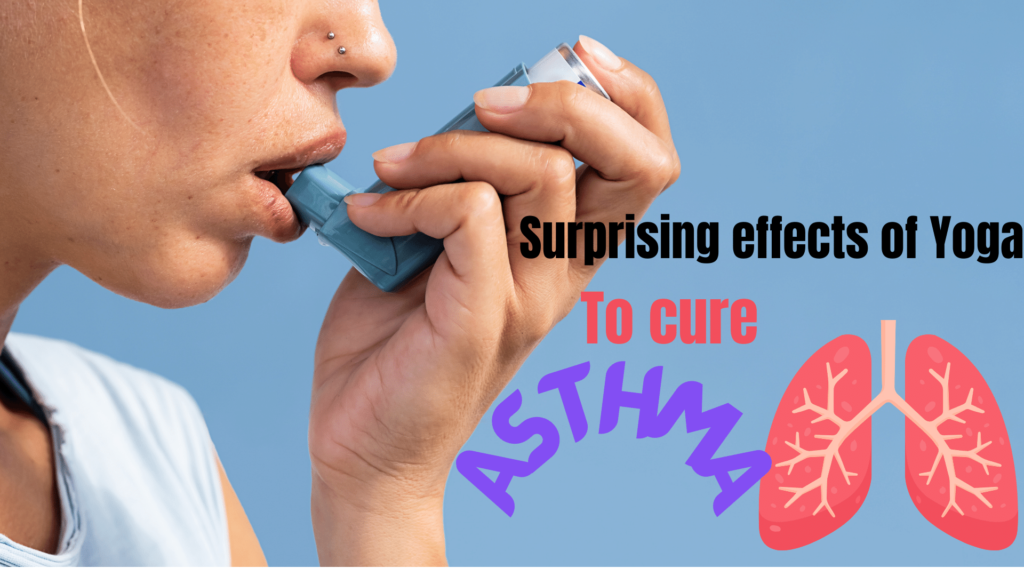Index of Contents
ToggleIntroduction
Asthma is a chronic lung disease that inflames and narrows the airways, making breathing difficult. It causes recurring periods of wheezing, chest tightness, shortness of breath, and coughing. Asthma symptoms can range from mild to severe and sometimes can be life-threatening.
The airway inflammation and narrowing that occurs with asthma is often triggered by allergens, irritants in the air, respiratory infections, exercise, extreme weather, or emotional stress. Symptoms may seem minor at first but can progressively worsen over time.
Yoga is an excellent complementary therapy that can help improve breathing and reduce asthma symptoms. A regular yoga practice teaches breathing awareness and control which can alleviate constricted airways. Certain postures also expand the lungs allowing for deeper fuller breaths. Additionally, yoga’s focus on relaxation lowers stress levels which further eases asthma flare-ups. With proper instruction, those with asthma can safely use yoga to gain more control over their symptoms.
Asthma Prevalence
Asthma is one of the most common chronic conditions, affecting over 25 million Americans. It is estimated that 7.1% of adults and 8.4% of children have asthma. Asthma rates have been rising, with the number of people diagnosed with asthma increasing by 4.3 million between 2008 and 2018 alone.
Asthma is particularly prevalent among children. According to the CDC, asthma accounts for 1 out of every 12 doctor’s office visits by children under 18. It is one of the leading causes of school absenteeism, accounting for over 13.8 million missed school days per year. Asthma is also the third leading cause of hospitalization among children under 15.
Certain populations are more vulnerable to asthma. African American children have a higher lifetime asthma prevalence of 17.1% compared to 12.9% in Caucasian children. Those living below the federal poverty level are also more likely to have asthma. The reasons for these disparities are complex, involving environmental, socioeconomic and genetic factors.
Clearly, asthma remains a significant public health concern in the United States, affecting millions of children and adults. Finding ways to better manage symptoms is crucial for reducing the burden of this chronic condition.
Asthma Triggers
Asthma is often triggered by substances in the environment that irritate the airways, causing them to swell and produce extra mucus. This makes the airways more narrow, resulting in symptoms like wheezing, coughing, and shortness of breath.
Some of the most common asthma triggers include:
-
- Allergens – Substances that provoke an allergic response, like animal dander, pollen, mold, and dust mites. Allergens cause the airways to become inflamed when inhaled.
-
- Irritants – Substances that directly irritate and inflame the airways, like cigarette smoke, air pollution, chemicals, and strong fumes.
-
- Weather – Changes in temperature, humidity, and air pressure can aggravate asthma. Cold, dry air is a common trigger.
-
- Illness – Respiratory infections like colds, flu, and sinus infections can worsen asthma. The extra mucus production further narrows the airways.
-
- Exercise – Physical activity, especially high intensity exercise, can trigger asthma symptoms due to the drying and cooling effect of heavy breathing on airways.
-
- Stress and emotions – Anxiety, laughter, yelling, and other strong emotions can sometimes precipitate asthma attacks. Stress hormones may cause airway inflammation.
-
- Medications – Some drugs like aspirin and NSAIDs can exacerbate asthma in sensitive individuals. Beta-blockers used for high blood pressure can also trigger attacks.
Knowing and avoiding your personal asthma triggers is an important part of keeping symptoms under control. Keeping an asthma diary can help identify exactly which factors affect your breathing.
How Asthma Affects Breathing
Asthma is a chronic inflammatory disease affecting the airways that carry air in and out of the lungs. During an asthma attack, the airways become inflamed and swollen, restricting the flow of air. The muscles around the airways also tighten, causing further narrowing known as bronchospasm. As the airways narrow, breathing becomes difficult.
Common asthma symptoms include:
-
- Coughing
-
- Wheezing
-
- Shortness of breath
-
- Chest tightness
The inflammation and bronchoconstriction make it harder to breathe air in and out. Asthmatics often describe feeling like they are “breathing through a straw”. Simple activities like walking upstairs can become challenging.
Asthma flare-ups can range from mild to severe. In rare cases, a severe asthma attack can completely block the airways and prove fatal if not treated promptly. While asthma can’t be cured, it can be effectively controlled in most people through proper treatment and management.
Benefits of Yoga for Asthma
Yoga can provide several benefits that help improve breathing and reduce asthma symptoms.
Improved Breathing and Lung Function
Certain yoga breathing exercises can help strengthen the diaphragm and expand the lungs. This helps increase lung capacity and oxygen flow throughout the body. Slow, deep breathing also helps calm the nervous system and relax the muscles around airways. Over time, a regular yoga practice can increase vital lung capacity and improve overall breathing function.
Reduced Inflammation
Asthma is characterized by chronic inflammation of the airways. The breathwork, poses, and meditation in yoga practice can help reduce inflammation throughout the body. This is due to increased circulation as well as the release of natural anti-inflammatory compounds during yoga. The reduction of inflammation in the lungs and airways can prevent asthma attacks and reduce severity of symptoms.
Decreased Asthma Attacks
With improved breathing capacity and less airway inflammation, there is a decrease in asthma episodes and flare-ups. Controlled yoga breathing sends more oxygen to the lungs and brings airways into balance. This helps prevent the bronchoconstriction and airway hyperresponsiveness that causes asthma attacks. Regular yoga practice is shown to significantly decrease the frequency and intensity of asthma exacerbations over the long-term.
Breathing Exercises
Of the many breathing exercises in yoga, pranayama techniques are especially beneficial for people with asthma. Pranayama involves controlling the breath through various breathing exercises that can increase lung capacity, improve breathing, and reduce asthma symptoms.
Some breathing techniques to try include:
-
- Ujjayi breath – Also known as victorious breath, this involves gently contracting the back of the throat to create an ocean sound as you inhale and exhale through the nose. The contraction helps regulate airflow.
-
- Nadi shodhana – Alternate nostril breathing involves breathing in through one nostril, retaining the breath, and exhaling through the opposite nostril. This calms the nervous system.
-
- Sitali breath – Curl the tongue and inhale through the mouth, then exhale through the nose. This cools and soothes the airways.
-
- Kapalabhati – Forceful exhalation by contracting the abdominal muscles, followed by passive inhalation. Helps clear airways.
-
- Brahmari – Inhale deeply then exhale while making a humming sound. The vibration is soothing.
Aim to practice these techniques for 5-10 minutes daily. Going slowly is key. Proper guidance from a yoga teacher is recommended when first learning pranayama. With regular practice, these methods can help strengthen lungs and improve breathing capacity.
Yoga Poses
Yoga incorporates various asanas (poses) that can provide benefits for people with asthma by opening the chest, improving posture, and facilitating deep breathing. Some beneficial poses include:
Standing Poses
-
- Warrior I – opens the chest and lungs.
-
- Warrior II – opens chest and shoulders. Strengthens back muscles.
-
- Extended Side Angle – expands chest and lungs.
-
- Tree Pose – improves balance and opens the chest.
Seated Poses

-
- Bound Angle Pose – opens the chest and hips.
-
- Camel Pose – expands the chest. Strengthens back muscles.
-
- Fish Pose – opens the chest and throat.
Prone Poses

-
- Cobra Pose – opens the chest and strengthens the lungs.
-
- Locust Pose – expands the chest and increases breathing capacity.
Supine Poses
-
- Bridge Pose – opens the chest and improves spinal extension.
-
- Reclined Bound Angle – opens hips and chest.
-
- Supported Fish – expands the chest in a supported, relaxed position.
Performing these poses regularly can help open the chest, improve posture, and teach proper breathing techniques for people with asthma. However, always listen to your body and avoid overexertion. Work within your limits and focus on slow, controlled movements.
Relaxation and Meditation
Asthma symptoms can often be aggravated by stress and anxiety. The relaxation and meditation aspects of yoga can help reduce stress levels and promote a sense of calm.
Practicing deep breathing exercises, visualization, and mindfulness meditation for just a few minutes per day has been shown to decrease stress hormones and lower blood pressure and heart rate. This can help prevent asthma attacks triggered by stress.
Some simple relaxation techniques to try include:
-
- Deep breathing – Inhale slowly through the nose, feel the belly expand with air, then exhale slowly through pursed lips. Repeat for 1-2 minutes.
-
- Body scan – Lie down and slowly scan up and down the body, noticing areas of tension. Consciously relax each muscle group.
-
- Guided imagery – Picture a peaceful place like a beach or forest. Focus on the details using all five senses. Visualize breathing in tranquility and breathing out tension.
-
- Mindfulness meditation – Sit comfortably and focus on the physical sensations of breathing. If the mind wanders, gently bring it back to the breath. The key is not to judge thoughts but simply observe them.
-
- Yoga nidra – Also called yogic sleep, this is a systematic full body and mind relaxation technique guided by a teacher.
Regularly making time for relaxation can lower stress levels and help manage asthma. Meditation also cultivates awareness of breathing patterns, which can be helpful for managing symptoms.
Yoga Precautions
When starting a yoga practice, it’s important for people with asthma to take precautions to avoid aggravating their condition. This involves being aware of certain poses or practices to avoid as well as modifications that can make yoga safer and more accessible.
Some key precautions include:
-
- Avoiding or modifying inversion poses where the head is lower than the heart, such as headstands or shoulderstand. These can restrict breathing.
-
- Avoiding poses that compress the stomach and abdomen, which can also make breathing more difficult. Modify poses like child’s pose if needed.
-
- Skipping breathing exercises involving breath retention or that are too rapid. Stick to slow, full breaths.
-
- Avoiding strenuous practices in extremely hot, humid studios which can trigger asthma symptoms.
-
- Drinking plenty of water before, during and after practice to avoid dehydration which can exacerbate asthma.
-
- Listening to your body and stopping or moderating any poses that cause wheezing, chest tightness or other symptoms.
-
- Having rescue inhaler on hand in case of an attack.
-
- Practicing yoga when asthma symptoms are well-controlled and avoiding practice if experiencing a flare-up.
-
- Starting slowly and gradually building an yoga practice tailored to your needs and current level of asthma control.
The key is to be in tune with your body, go at your own pace, and modify or avoid anything that seems to aggravate asthma symptoms. With the right precautions, yoga can be safe and helpful for managing asthma.
Developing a Practice
Tips for Starting a Yoga Routine
Yoga can be extremely beneficial for people with asthma, but it’s important to start slowly and listen to your body as you develop your practice. Here are some tips for getting started with yoga for asthma relief:
-
- Consult your doctor before trying yoga, especially if your asthma is severe. Make sure poses and breathing exercises won’t exacerbate your symptoms.
-
- Look for beginner yoga classes that move at a slow pace. Avoid hot yoga or fast-paced styles like power yoga when first starting out.
-
- Start with just 5-10 minutes per day. This allows your body to adjust and prevents fatigue. Gradually increase your practice as you feel comfortable.
-
- Focus on poses that open the chest and improve breathing. Poses like Child’s Pose, Cat/Cow, and Supported Fish Pose are great options.
-
- Learn modifications to make poses more accessible. Using props like blocks and straps can help you avoid strain.
-
- Pay attention to your breathing. Try to breathe slowly and deeply through your nose during yoga.
-
- Take breaks as needed. Don’t feel like you have to hold poses for a certain time if you experience discomfort.
-
- End each session with deep breathing and meditation. This allows you to relax and observe how you feel after practice.
-
- Keep medications nearby in case of an asthma attack. Stop immediately if you have trouble breathing.
-
- Be patient and celebrate small improvements. Over time, yoga can significantly reduce asthma symptoms and improve quality of life.



